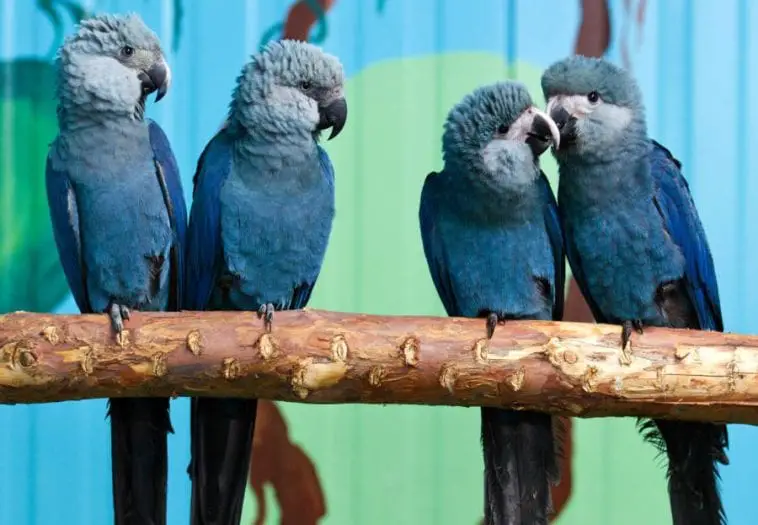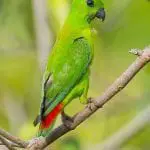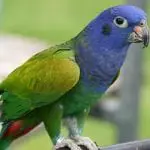Scientific Facts
| Common Name: | Spix’s Macaw, Little Blue Macaw |
| Scientific Name: | Cyanopsitta spixii |
| Life Span: | Up to 38 years |
| Weight: | 288 to 318 grams |
| Length: | 56 centimeters |
| Habitat: | Tropical areas, forests, and terrestrial areas that are near streams and rivers |
| Country of Origin: | Brazil |
Physical Description
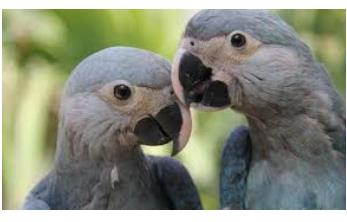
The plumage of the Spix’s macaws is colored with a dull blue with a faint green tinge towards their abdomen and their chest area. The upper side of the back and tail are a deeper blue, the bare pores and cheeks are dark grey, and their ears and foreheads are colored with a pale bluish-grey color. The underside of their tails and their wings are also colored with a dark grey. On the other hand, their bills are smaller and black in color. Their feet are also grey while they irises are colored with a pale yellow. Their wingspans are 1.2 meters wide, and their basal metabolic rates are 1.425 cm3 of oxygen per hour. On average, they weigh around 310 grams, and they are about 56 centimeters in length.
Hatchlings and young Spix’s macaws have shorter tails compared to the adult ones, and their upper mandibles are horn-colored with blackish sides. Also, their irises are brown in color. For adults, distinguishing the sexes can be hard because they typically look the same.
Conservation Status
At present, the Spix’s macaws can be considered as the rarest and most protected species of bird in the entire world. They are practically extinct in the wild as the population has been decreased into one single male individual left in the wild. They also have no known subspecies to continue their legacy. There are many causes for the near-extinction of the species, but the three main reasons for these are hunting by the indigenous people of Brazil, African bees occupying the nests and killing young macaws, and trapping activities made by poachers. Because of the uniqueness and scarcity in the wild, trappers and poachers have captured juveniles, adults, and eggs from their nests for decades. These poachers sold them to local zoos, smuggled to send them to international zoos, and wealthy private owners. In 1987, it was recorded that these birds cost around 40,000 dollars, and the price has probably tripled in recent years, leading to near-extinction.
Availability and Natural Habitat
The Spix’s Macaw used to be found in the interior of northwestern Brazil, specifically in the small areas of southern Piaui, southern Maranhao, northwestern Bahia, and northeastern Goias. At one time, it was believed that these little birds prefer to live in groves of buriti palms because of their diet, which is mainly the nuts produced by these palms. However, these small birds have observed in the arid regions called the Tabebuia carabia woodlands, where very few palms can be found.
The macaws have also been found to favor the dead crowns of craibera trees as perches, which would also mean that they use these trees as nesting sites.
However, they have been declared extinct in the wild, and they are now grown in captivity. One report states that this is the breakdown of the Spix’s macaw in captivity are:
- Loro Parque, Tenerife, Spain – 2 birds
- Philippines (private keeper) – 4 birds
- Brazil (private keeper) – 20 birds
- Walsrode Birdpark, Germany – 4 birds
- Qatar (private keeper) – 4 birds
- Switzerland (private keeper) – 18 birds
- Naples Zoo, Italy – 1 bird
- Sao Paolo Zoo, Brazil – 3 birds
- Other sites with unknown populations: Japan, Portugal, United States of America, and Yugoslavia
Lifespan
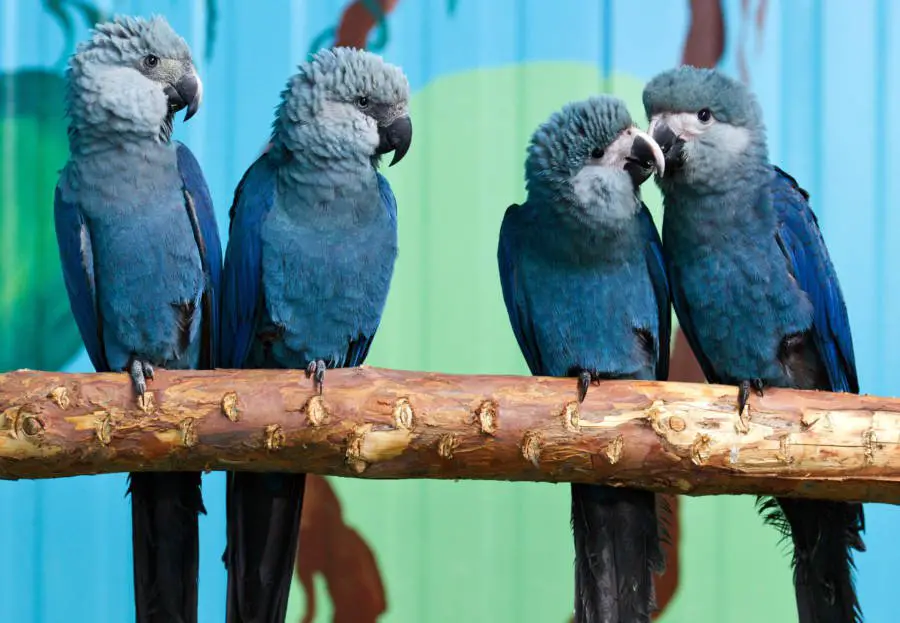
The Spix’s Macaws has a lifespan of 28 to 38 years, but this is considerably shorter than other larger macaws, but it is very similar to their other relatives, Illiger’s macaws, which has a lifespan of about 30 years. However, the eggs of these birds, fledglings, and even adults have been constantly taken from the wild, and it can be difficult to identify their lifespan in captivity.
Behavior, Exercise, and Training
Embed Code: <iframe width=”640″ height=”360″ src=”https://www.youtube.com/embed/JsKH49L6dh0″ frameborder=”0″ allow=”accelerometer; autoplay; encrypted-media; gyroscope; picture-in-picture” allowfullscreen></iframe>
Spix’s macaws love having routines in their lives. They observe the same flight path, same scavenging activities, and bathing at the same time each day. They also incorporate their routines in how they deal with their relationships with their mates. For instance, single males in the wild can be observed to escort their partners back to their nest at the same time each day before returning to their own home. Spix’s macaws also enjoy traveling in pairs or small groups of birds when they hunt for food or look for their nest.
The Spix’s macaws are active during the daytime, and they usually spend their nights on the streams. They usually can be found perched on the top of branches of trees near the rivers. They fly with slow, deep wing-beats that are similar to larger macaws and are accompanied by their calls that sound like kraa-ark. If intruders approach them, they can either take off or try to intimidate the intruder by their loud voices.
Like many other species of macaw, Spix’s macaws are masters of mimicry. They can imitate the voices of humans and talk about the way humans do. Macaws are lively, noisy birds that rarely fly more than a few feet without letting out their cry. Though they have not been observed living together in larger groups, scientists believe that the birds used to travel in flocks of about 15 birds, which is how they learned the importance of oral communication.
Food and Eating Habits
Embed: <iframe width=”636″ height=”360″ src=”https://www.youtube.com/embed/-WsnLHBnGsU” frameborder=”0″ allow=”accelerometer; autoplay; encrypted-media; gyroscope; picture-in-picture” allowfullscreen></iframe>
The Spix’s macaws in the wild usually eat the seeds of faveleira trees and the pinhao-brabo trees. They have also been observed to eat the fruits of the pau de colher cacti, zizyphus joazeiro cacti, the licuri palm, and the fachiero cacti.
In captivity, keepers usually provide their little blue macaws with a variety of seeds, fruits, and nuts. They are also supplemented with vitamins and minerals to make sure that they stay healthy. They can also be fed with eggs, porridge, and small amounts of pre-cooked beef or chicken.
Breeding
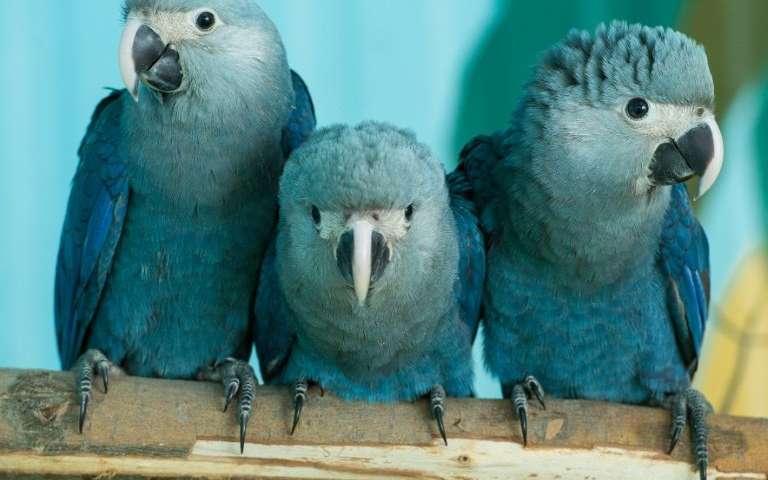
Like other macaws, the Spix’s macaws are monogamous in nature, and they mate for life. It is also suspected that when this species is more abundant, the males compete for the attention of the females. However, since their population was damaged, it is near impossible to dictate and study their natural behavior.
In the wild, the Spix’s macaws breed between November and March. Their clutch usually comprises of two to three eggs and is placed within the hollows of dead craibeira trees. These nests that they create are generally reused each year, which is why their young can easily be poached by illegal bird traders when they hunt for the young each season.
Because these birds have extremely small crops, the baby Spix’s macaws require more frequent feeding compared to other macaws. During this time, it is essential that the adults are undisturbed because they might injure or destroy their eggs.
Breeding in captivity has been achieved by many expert keepers. Courtship usually happens immediately every August and is immediately signaled by mutual feeding, increased aggressiveness towards their keeper, and longer periods of treading. Similar to how it is in the wild, the clutch is about two to four eggs laid in two-day intervals, but not all eggs end up as fertile. Incubation usually lasts for 26 days, the chicks fledge within two months and start to become independent within five months. After 7 years, the Spix’s macaws reach sexual maturity.
Environment and Housing
In captivity, it is recommended for the Spix’s macaw to live in a wide and spacious aviary with an adjoining shelter with a size of 3 meters by 2 meters by 2 meters. This living space must be located in an area that is peaceful and quiet because these birds can be easily distracted, especially during their breeding season. The areas inside of their living spaces must be filled with perches, including a tree stump that is approximately 35 cm in diameter and 70 cm in height plus an entrance hole that is 10 cm in width.
Fun Facts about the Spix’s Macaw
- The Spix’s macaw is named after Johann Baptist von Spix, which is a German naturalist who hunted and collected one of the birds in Brazil in 1819.
- The Spix’s macaw is also known as the little blue macaw because it is smaller and more vividly colored compared to other species.
- It is hard to identify between sexes of these birds as the males and females look alike and are roughly the same size.
- The Spix’s macaw was believed to inspire the animated film, Rio, which was released in 2011.
- The natural habitat of the Spix’s macaw was credited to be Tabebuia caraiba gallery woodland beside seasonal creeks, the caatinga, and the dry scrub zone.
- The parent Spix’s macaws are known to protect their young during the breeding season aggressively.
- When these birds feel threatened, the birds lie on their side on the ground to draw intruders away from the nest.
Where Can You Get a Pet Spix’s Macaw?
At present, there is no legal way to obtain a Spix’s macaw as the limited population of the birds is in captivity with private keepers and collectors or government-operated and non-government conservation organizations.
How to Care for a Spix’s Macaw?
Embed: <iframe width=”480″ height=”360″ src=”https://www.youtube.com/embed/lzdr-dnavwQ” frameborder=”0″ allow=”accelerometer; autoplay; encrypted-media; gyroscope; picture-in-picture” allowfullscreen></iframe>
Spix’s macaws are noisy and energetic with playful personalities. They can be aggressive, but wild-caught birds are initially very shy and will take a few weeks or days to get used to their keepers. Once they have acclimated in their new habitat, they can be quite hardy.
They require a housing environment that looks like large aviary set-ups with adjoining shelters. Wood construction is not recommended for Spix’s macaws as they love chewing, and they can destroy the flight quite easily. A metal structure with a strong mesh is usually chosen for these birds. The aviary must be situated in a quiet area that will not distract the birds from their breeding efforts. Temperatures must also be well-maintained and should not go any lower than 20 degrees Celsius.
Spix’s Macaws in captivity can be fed with a variety of the following:
- Safflower seeds, hemp seeds, oats, wheat, canary grass seeds, and various millets
- Palm nuts and pine nuts, in moderation
- Fruits and vegetables like rosehip, rowanberries, corn, carrot, banana, apple, and plum
- Chickweed, dandelion, greenwood
- Soaked pigeon food
- Small quantities of cooked beef, eggs, porridge, and rusk
- Avian vitamins especially vitamin D and vitamin B complex
- Tree bark and cactus meat
Frequently Asked Questions
How much does a Spix’s macaw cost?
In the late 1980s, it was recorded that these birds cost about 40,000 US Dollars, but it is believed that the price has tripled since then because of the extreme rarity.
How many Spix’s macaws are left?
The Spix’s macaws have been reduced to one individual in the wild, and an estimate of 50 to 100 exist in captivity.
Is the Spix’s macaw extinct?
According to the last recent report by the IUCN Red List in 2018, the species of the Spix’s macaw is seen as critically endangered. But, according to Nigel Collar of Birdlife International, this bird is now seen as extinct in the wild.
What type of macaw is Blu from Rio?
The character Blu from the animated film Rio is inspired by the Spix’s macaw. In this film, Blu flies from the United States all the way to Rio de Janeiro because he is the last living male of the species, and that’s where the last female, named Jewel, lives.
Where does the Spix’s macaw live?
The Spix’s macaws have been recorded to live in a small area in northeastern Brazil.

